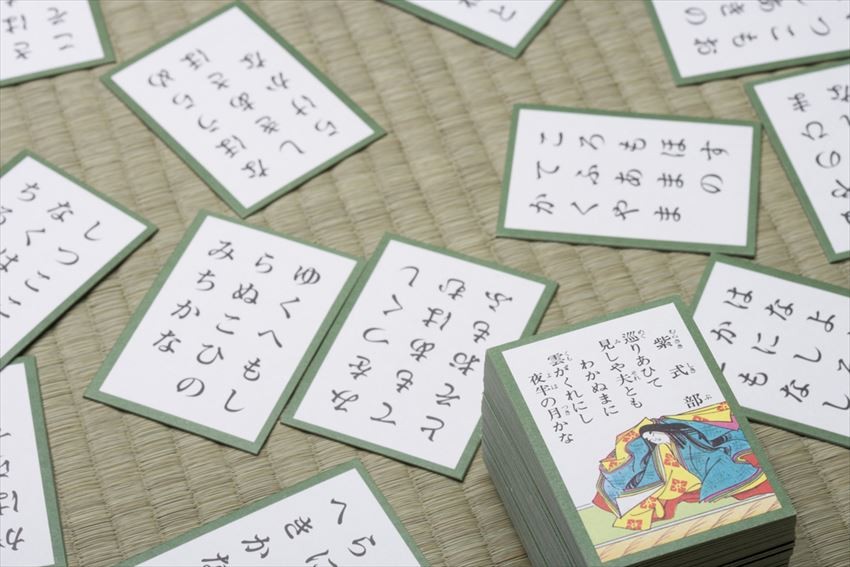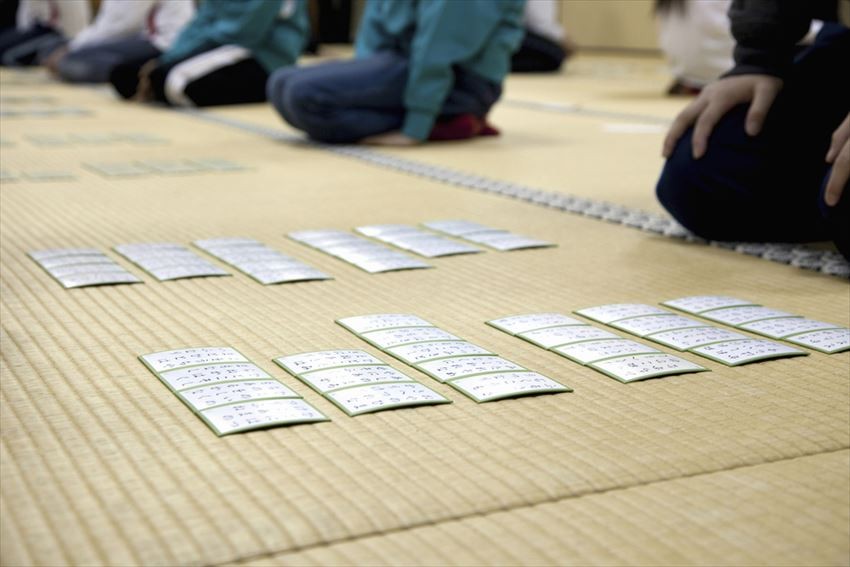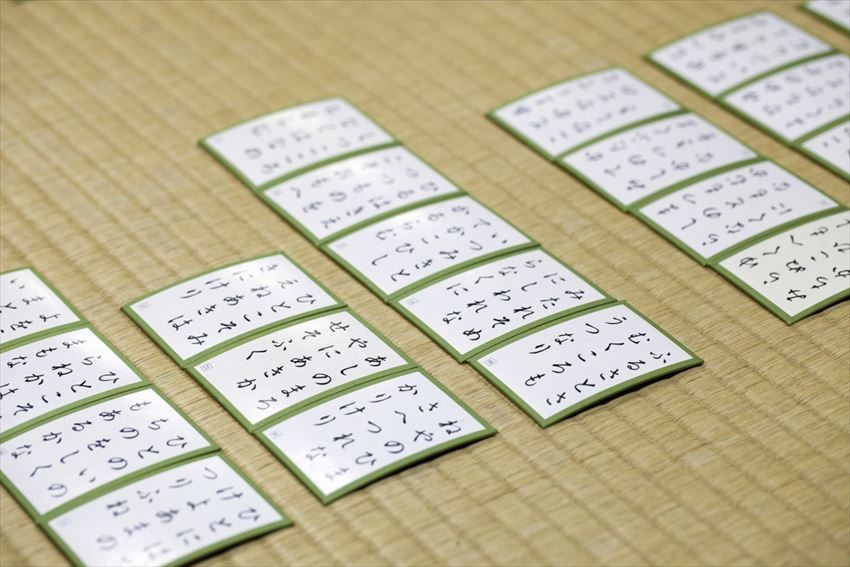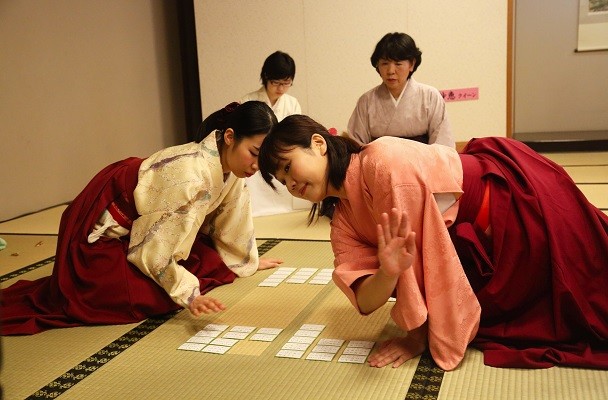A girl's manga "Chihayufuru", written by manga writer Yuki Suetsugu, is based on the theme of "Competition Karuta". It was also animated and adapted into a movie, with Suzu Hirose who starred in the movie has become a hot topic. For Japanese, "Karuta" is a game where Japanese gather and enjoy together with relatives and families during the New Year when they are young. At least half of the Japanese population have experienced playing Karuta, however more than half of them do not really know the history and rules of Karuta, as well as how to enjoy playing it. In this article, we would like to thoroughly explain "Competition Karuta" to you all!

What is "Competition Karuta"?

It is a competition that is played by using "Karuta" which is written in "Ogura Hyakunin Isshu". " Ogura Hyakunin Isshu " is a poem collection of 100 poets, which were selected by the poet Teika Fujiwara who was active from the Heian period to the Kamakura period.
In 'Competition Karuta', the cards used are written with the 'upper phrase' and 'under phrase' of these 100 poems. After listening to the "upper phrase" which is read by the reader, the player needs to take the card with the "lower phrase" as fast as possible, and the player who finishes their holding card will be the winner.
Besides “Competition Karuta” which is played with poems of "Ogura Hyakunin Isshu", there are also "Iroha Karuta" which is played using "Iroha poems", and all of them are passed down until current generation, and are played on the New Year.
What is the history of "Competition Karuta"?

It is said that in 1904 (Meiji year 37), journalist Kuroiwa Ruiko executed the unification of game rules, etc. which have been used in traditional competitions across Japan. After that, it was spreading throughout the country from Taisho to the early Showa era, and the "Japan Karuta Association" was established in the year 1948 (Showa 23rd) to manage the events. There are ranks such as "Competitive karuta master position Queen Position final”, "Nationwide selection karuta Competition", "Female National Competition Karuta Championship" which competing for the highest rank of competition Karuto. The winner of the “Competitive karuta master position Queen Position final” will be named as master/queen. “Competitive karuta master position Queen Position final”matches are held at Omi Jingu, Shiga prefecture, and the final competition is aired on TV every year.
What is the flow and rules of "Competition Karuta"?
■ Flow of the Game
1) For the individual competition, the competition is played by one person to one person. Mix 100 cards of “Hyakunin Isshu” well with the words facing down, and select 25 card for each player. These 25 cards are called "mocha-satsu" and placed on the player's field. It is then divided into three rows and arranged freely by the player. The field which is within the player's own territory is called “Jijin” while the field of the opponent is called “tekijin”. The remaining 50 sheets are not used for competition.
2) The player will be given 15 minutes to memorize the cards of both your field “jijin” and the opponent’s field, “tekijin”.
3) At the start of the game, both player will pay respect to each other. Then, a poem which is not related to “Hyakunin Isshu” is read at first, the competition starts from the second poem after this.
The players need to listen to the upper phrase that is read by the reader, if the card of the read one exists on the field, the player need to touch the card first and this action is called "tori". If you pick up a card from your own field, you managed to reduce the number of cards on your side. If you take the opponent’s field card, you can pass one card of your filed to your opponent’s field (Okuri-satsu). After repeating this, the player who finishes their cards first will be the winner. Also, there will be 50 poems which are not on either your field or the opponent’s field, and is called as "Karafuda".
■ Rules that you have to know
1) In the case that there are no related card on the field but the player has wrongly touch the card on field, it is called as “Otetsuki”. When your opponent has performed “Otetsuki”, you can send one card of your field to your opponent’s field.
However, if the field you touch actually has correct card, no matter which card you touch on that field is not counted as “Otetsuki”.
Cases of "Otetsuki"
・The card is on your own field but you have touched the card on your opponent’s field.
・The card is on your opponent’s field, however you have touched the card on your own field.
・The card of the read poem is not on either field(Karafuda), but you have touched a card on the field.
2)The player is only allowed to use one hand, and is not allowed to use both hands throughout the entire game. You have to use the same hand which you used at the start of the game in this match.
3)You can move the layout of the cards freely if you informed the opponent before you move.
What are the tips to win in "Competition Karuta"?
1)Remember the upper phrase and the “Kimari-ji” of 100 poems for Hyakunin Isshu.
In order to get the card quickly, it is important that you know the upper phrase of all the poems of “Hyakunin Isshu” and its “Kimari-ji”. A “Kimari-ji” is the letter which will help you to identify the answer after listening to a few word of the upper phrase.
For example, a poem of "Chihayaburu Kamiyomokikazu Tatsutakaha (Upper Phrase) Karakurenanuni Midukukurutoha (Lower phrase).
Even though there are two phrases begining with "chi", since the head of both phrases are "Chigi", if you listen until "chiha" then you should be able to find out the answer very quickly. These two letters are called "Kimari-ji". If you know "Kimari-ji", you can find out which lower phrase it is without having to listen to the whole sentence of the upper phrase, and you can get the card faster and correctly.
・Chigiriokishi Sasemogatsuyuwo Inochinite (upper phrase) Aharekotoshino Akimoinumeri (lower phrase)
・Chigirikina Kataminisodewo Shiboritsutsu (upper phrase) Su wenomatsuyama Namikosajitoha (lower phrase)
2)Instantaneous power and concentration will help you find the card quickly after listening to upper phrase!
Besides memorizing ability, you will need instantaneous power and quick reflexes to play competition Karuta. The speed of listening to the upper phrase, find out the lower phrase, find the actual card and pick up are all very important. The time limit for each game is about 90 minutes. Concentration and endurance are also essential for this competition.

Comments